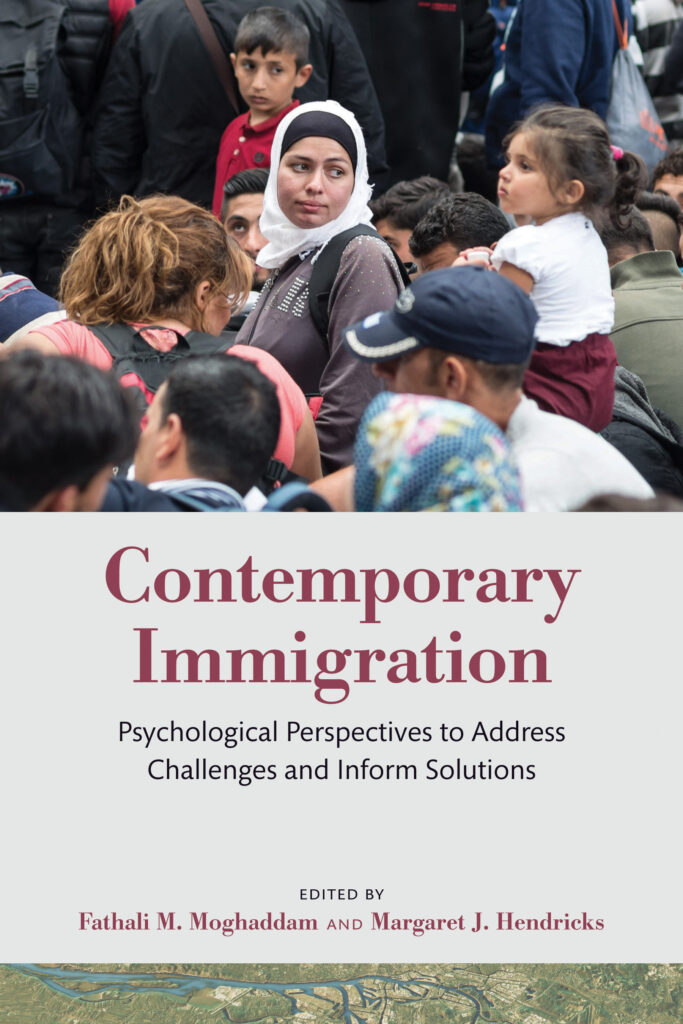Understanding the Psychology of Immigration Through an International Framework
During the past three decades, the number of people migrating from one country to another has risen sharply, from 153 million in 1990 to 281 million in 2020 — some 3.6 percent of the world population.
The reactionary politics that arise from the mass movement of individuals across political borders is at the center of a new book, Contemporary Immigration, from Fathali Moghaddam and Margaret Hendricks.
“Contemporary Immigration is inspired by the importance of immigration in the current century,” Moghaddam explains. “Globalization involves a massive movement of people around the world, and this movement involves dissimilar others arriving in large numbers.”
Moghaddam, a Professor in Georgetown’s College of Arts & Sciences Department of Psychology, advised Hendricks on her Ph.D., which she recently completed.
Local Problems, Global Perspectives

“I wanted to study immigration as part of my dissertation research,” explains Hendricks, who won a prestigious Presidential Management Fellowship and works at the National Highway Traffic Administration. “We were discussing the current research on immigration and psychology, and realized that while there was a lot of research on it there was no international collaboration.”
To broaden the psychological perspective on immigration, the team worked on synthesizing disparate research from around the globe, comparing both results and methodologies.
“It was a great way to bring together international researchers and the international community,” Hendricks says. “The book does a great job of providing a broad overview. And we found similarities between countries, both the criminalization of immigration and positive.”
For Moghaddam, the political debates around immigration are essential to the work. In the United States, immigrants are no longer arriving from Europe in the same numbers as in the 20th century. Instead, immigrants are coming from Africa, Asia and South America, and these groups are facing significant levels of discrimination and hostility.
“It’s the perception of threat that drives a lot of the politics in America at the moment,” Moghaddam says. “The perception arises from the arrival of large numbers of dissimilar others. Through a psychological study of social relations, we find that a bias against seemingly different others arises between racial, ethnic and religious groups.”
The Struggle for Equity
The interplay between social psychology and politics leaves large swathes of immigrants caught in legal limbo, trapped between fiery nativist politicians and systems unwilling to change.
“For the next few decades, we are going to be struggling with this issue,” Moghaddam predicts. “Fears of immigrants played heavily into Brexit, into Le Pen’s growing popularity in France. The rise of extremist Christian nationalists in Europe parallels the rise of extremist Christian nationalists in the United States.”
Despite the nativist impulses, the economy, both domestically and globally, demands an influx of workers.
“Immigrants drive the U.S. economy,” Moghaddam says. “But people basically like others they see to be similar to themselves and they don’t like those they see as dissimilar.”
That similar-dissimilar dichotomy doesn’t contain the whole story, though.
“The book also highlights the tension between, on the one hand, people being attracted to similar others and, on the other hand, the celebration of differences leading to a focus on intergroup differences rather than similarities,” Moghaddam explains.
Despite the team’s dour outlook for the immediate political future, they find some psychological frameworks that inspire hope.
“The book explores two possible solutions to the better integration of immigrants,” Moghaddam explains. “Increasing direct and indirect contact between ethnic groups, and developing a stronger common or superordinate identity that better encompasses all ethnic groups.”
Contemporary Immigration: Psychological Perspectives to Address Challenges and Inform Solutions is out September 13 from the American Psychological Association.
-by Hayden Frye (C’17)
- Tagged
- Books
- Faculty
- Psychology
